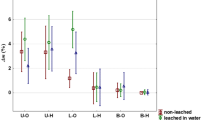Abstract
The susceptibility of rubber (Hevea brasiliensis) wood to marine borer attack limits its use for marine purposes. In the present study three types of biocides viz. copper creosote, arsenical creosote and a dual preservative treatment with copper- chrome- arsenic and creosote were selected for comparing their relative efficacy in preventing biodeterioration. The treated panels were exposed at the test site in Cochin harbour. The extent of internal damage through marine borer attack was assessed through visual observations, X-ray photographs and mechanical strength testing. The untreated test panels were destroyed within six months whereas it was found that preservative treatment prevented biodeterioration under marine conditions. This was confirmed by radiographic studies and comparison of compressive stress at maximum force. The service life of this cheaply and easily available timber can be increased to meet the growing demand of timber in the small-scale fisheries sector.
Zusammenfassung
Die Anfälligkeit von Gummibaumholz gegen den Angriff von Bohrmuscheln begrenzt seine Verwendung für die Seefahrt. In dieser Studie werden drei Typen von Bioziden ausgewählt, nämlich Kupfer-Kreosot, Arsen-Kreosot und eine zweifache Schutzbehandlung mit Kupfer-Chrom-Arsen und Kreosot. Die entsprechenden Schutzwirkungen gegen biologischen Abbau wurden ermittelt und verglichen. Die behandelten Platten wurden im Hafen von Conchin zur Prüfung ausgesetzt. Das Ausmaß der Schädigung durch Bohrmuscheln wurde visuell, mittels Röntgenaufnahmen sowie durch Prüfen der mechanischen Festigkeit bestimmt. Die unbehandelten Proben waren innerhalb von sechs Monaten zerstört, während die Schutzbehandlung den biologischen Abbau im Meer verhinderte. Das wurde bestätigt durch radiographische Untersuchungen und Drucktests bei maximaler Last. Die Lebensdauer dieses billigen und leicht erhältlichen Schnittholzes kann soweit erhöht werden, dass die Anforderungen des kleinen Wirtschaftssektors der Fischerei erfüllt werden.



Similar content being viewed by others
References
Barnacle JE (1976) Wood and its preservation in the sea—a resume. In: Proceedings of the Fourth International on Marine Corrosion and Fouling, Boulogne, Rome, pp 57–69
Damodharan TK, Gnanaharan R (1994) Upgradation of rubber wood KFRI Research Report no. 93. Kerala Forest Research Institute, Peechi
Edwin L, Thomas SN (2000) Creosote and Copper-Chrome-Arsenic (CCA) treatment on the compressive strength of Adina cordifolia (Haldu). Fishery Technology 37(1):1–4
Edwin L, Thomas SN, Nair NU, Ravindran K (1993) Dual preservative treatment for small fishing vessels—observation on the biodeterioration of Mango wood. In Low Energy Fishing, Fishery Technology (Spl. Issue) SOFT (I), India, pp 98–102
Gnanaharan R, Damodharan TK (1992) Mechanical properties of rubber wood from a 35 year old plantation in Central Kerala, India. J Trop Forest Sci 6:12–16
Gnanaharan R, Mathew G (1982) Preservative treatment of rubber wood (Hevea brasiliensis) KFRI Research Report: 15. Kerala Forest Research Institute, Peechi
Goh TA, Chong KF, Tam MK (1983) Preservative treatment of green rubber wood (Hevea brasiliensis) by vacuum pressure impregnation. Malaysian Forester 46:375–386
Hong LT, Mohd AS, Tan AG, Singh KD (1982) Preservation and protection of rubber wood against bio-deteriorating organisms for more efficient utilization. Malaysian Forester 45:299–315
Hunt GM, Garrat AG(1953) Wood preservation. McGraw-Hill, New York, p 417
Johnson BR (1977). Performance of single and dual treated panels in a semi- tropical harbour. Progress Report No.2. Proc Am Wood Preserv Assoc 73:174−198
Lahiri AK (1996) Mechanical strength properties of green, air dried and preservative treated 153 timbers of Bangladesh. J Timber Develop Assoc 40:15−18
Nair NU, Gopalakrishna Pillai AG, Balasubramanyam R (1972) Studies on arsenical creosote as a wood preservative for marine structures. Part I. Incorporation of arsenic in creosote at various temperatures. Fishery Technology 9:76–80
Rao KS, Santhakumaran LN, Balaji N, Srinivasan VV (1993) Natural resistance of rubber wood to marine borers and preliminary note on the effect of preservative treatment. Ind J Nat Rubber Res 6:71–74
Ravindran K, Gopalakrishna Pillai AG, Nair NU (1985) Copper creosote—a new preservative for marine wooden structures. In: Ravindran K, Nair NU, Perigreen PA, Madhavan P, Gopalakrishna Pillai AG, Panicker PA, Mary Thomas (eds) Harvest and post harvest technology of fish. Society of Fisheries Technologists (India), Cochin
Shukla S, Lal M (1985) Physical and mechanical properties of Hevea brasiliensis (Rubber wood) from Kerala. J Timber Develop Assoc 31:29–30
Sunder Rajan P (1989) Rubber wood the timber with a promise. Rubber Asia, September—December, 1989
Thomas SN, Edwin L, Ravindran K (1998) Effect of single and dual preservative treatments on the strength of boat building timbers. In: Balachandran KK, Iyer TSG, Madhavan P, Joseph J, Perigreen PA, Raghunath MR, Varghese MD (eds) Advances and priorities in fisheries technology. Society of Fisheries Technologists, India, pp 117–120
Varma V, Gnanaharan B (1989) Field evaluation of preservative treated rubber wood (Hevea brasiliensis) against subterranean termites. Material und Organismen 24:287–290
Acknowledgement
The authors express their sincere gratitude to Dr. K. Devadasan, Director, CIFT for the encouragement given. Thanks are also due to the technical staff of the Material Science and Marine Pollution Section for the support rendered and to Dr. Nikita Gopal, Scientist, CIFT for helping in the statistical analysis.
Author information
Authors and Affiliations
Corresponding author
Rights and permissions
About this article
Cite this article
Edwin, L., Pillai, A.G.G. Resistance of preservative treated rubber wood (Hevea brasiliensis) to marine borers. Holz Roh Werkst 62, 303–306 (2004). https://doi.org/10.1007/s00107-003-0460-z
Published:
Issue Date:
DOI: https://doi.org/10.1007/s00107-003-0460-z




